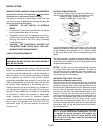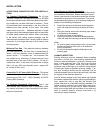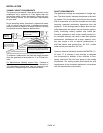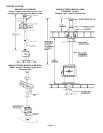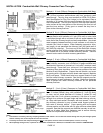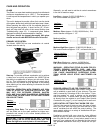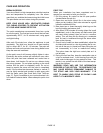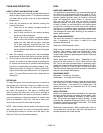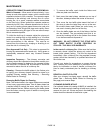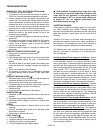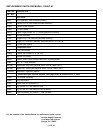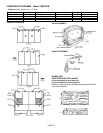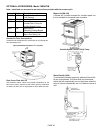CARE AND OPERATION
PAGE 15
BREAK-IN PERIOD
Your stove finish is a high temperature paint that requires
time and temperature to completely cure. We recom-
mend that you ventilate the house during the initial burns.
The paint emits non-toxic odors during this process.
KEEP YOUR HOUSE WELL VENTILATED DURING
THE CURING PROCESS TO PREVENT ACTIVATION
OF YOUR HOME SMOKE DETECTOR.
The paint manufacturer recommends three burn cycles
to cure the paint. The first two burns should be low heat,
approximately 250°F., for 20 minutes each, using paper
and light kindling.
After each 20-minute burn, allow the appliance to cool
completely. The third burn should be at least medium
high or about 450°F. for 45 - 60 minutes. The paint will
become soft and emit non-toxic haze during these burns.
Keep the area well ventilated.
As the paint cures it will become slightly lighter in color.
Eventually the entire surface will become an even color.
Once the paint has been softened and cooled two or
three times, it will harden. Do not turn on a blower during
the curing process. Do not place anything on the stove
surface until the paint is completely cured. Do not at-
tempt to repaint the stove until the paint is completely
cured. If the surface later becomes stained or marred, it
may be lightly sanded and touched up with spray paint
from the same paint (See Small Area Paint Touch-up,
page 17). Paint is available at your local authorized Len-
nox Hearth Products dealer. Never attempt to paint a hot
stove.
FIRST FIRE
When your installation has been completed and in-
spected you are ready to build your first fire.
1. Pull the primary air control to the full open position
(located below the ash lip).
2. Open door and build a small fire in the stove using
paper and dry kindling. Wait a few minutes for a good
updraft to establish the fire.
3. Now place two or three thoroughly dried logs on the
burning kindling and secure door.
4. After about 25-30 minutes of burning (when fire is well
established), push in the primary air draft control (this
will reset control plates), then pull out to a medium
setting. This will keep the fire burning at a moderate
level so heat is transferred through the stove rather
than up the chimney.
5. Once a bed of coals has been established, adjust the
air-intake draft control to a low by pushing the air con-
trol rod all the way in (closed) and then pulling the rod
out incrementally to a low or medium-low setting.
This action clears the high burn control plate so it is
not left open.
6. During the first few fires, keep the combustion rate at
a low to moderate level. Avoid burning fires with the
draft control wide open for long periods of time. This
results in an updraft fire with most of the heat escap-
ing up the chimney.
WARNING! READ AND USE THE INFORMATION
PROVIDED IN THIS SECTION. TO DISREGARD THIS
MAY CAUSE SERIOUS PERMANENT DAMAGE TO
THE STOVE AND VOID YOUR WARRANTY. IT IS
BEST TO WARM YOUR STOVE UP SLOWLY AND
KEEP IT AT A MODERATE LEVEL.



